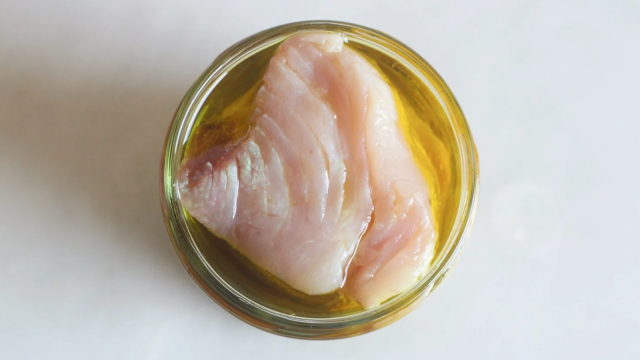I have always appreciated a good tuna sandwich. You can make a good one even with mediocre, water-packed fish, though you will have to lean heavily on condiments and seasonings. Fancy oil-packed tuna lets one highlight the fish a little more. But tuna confit? That fish is so good, it barely needs any mayo (a statement that, coming from me, bears a lot of weight).
Good tuna confit is all about temperature control. The tuna is gently poached in olive oil (or another oil of your choice) until it firms up ever so slightly, resulting the a very tender, very moist piece of fish. It will put to shame whatever store-bought stuff you have hanging out in your pantry and — if you have a precision cooker — making it will only take half an hour.
There are a lot of tuna confit recipes out there. Some contain garlic, lemon zest, peppercorns, and hot peppers, but I don’t think any of that is needed if you have a nice peppery olive oil. A quick dry cure before the tuna goes into the bath provides plenty of seasoning (and draws out some water) while letting the flavour of the fish shine. You can, of course, add any flavouring agents you desire; just keep in mind you are cooking the fish in a low-temperature, oxygen-free environment, which botulism loves, so you’ll want to eat your confit within a day or two. (You should probably do that anyway.)
For the tuna, use albacore if you can find it. If you can find a loin, that’s perfect, but you can use steaks, or even kabab-cubed chunks. I was lucky to find a large loin so late in the season, and I took the opportunity to chop it up and precision cook it at three different temperatures to find my favourite.
Before you even set the temperature, you’ll want to break your fish down into fairly even 2-3cm thick pieces. Don’t worry if they’re not completely uniform — fish do not come in perfectly symmetrical shapes — just do your best (which I’ve heard is very good).
Next, coat each piece with a generous amount of salt. I used table salt (the saltiest), but any fine-ish-grain salt will work fine. It should look like this:
Lay the pieces of salted tuna on a plate and let them hang out in the fridge for 20 minutes. In the meantime, fill a heat-safe tub or container with water and set your temperature. Anywhere between 45 and 50 degrees Celsius will work well; it’s a matter of your textural preferences.
I cooked three portions of the fish for half an hour each at 45, 47, and 50 degrees Celsius. As you probably could have guessed, the higher the cooking temperature, the firmer the fish. At 45 degrees, the tuna had a slight sashimi quality, and bounced back when pressed with a fork, leaving only a slight indent. At 47 degrees, it flaked slightly when pressed with a fork, though it mostly just mushed beneath the tines. The tuna cooked at 49 degrees was quite flakey, though still extremely moist and tender. For me, the tuna cooked at 45 degrees occupied an uncanny valley between raw and cooked. The tuna cooked at 50 degrees was my personal favourite — it’s perfect on a sandwich — but the tuna cooked at 47 degrees would be sublime in a salade niçoise.
Though I decided to store my tuna confit in an old jam jar, I cooked it in a freezer bag. It’s far faster without the thick glass, and honestly I’m out of clean mason jar lids (jam jar lids do not seal well enough). Because you’ll be cooking the fish at a fairly low temperature, there’s no need for super thick vacuum bags. Ziploc will work just fine.
Precision-Cooked Tuna Confit
Ingredients:
- Albacore tuna loin or steaks, at least 220g
- Salt
- Olive oil
Instructions:
Cut the tuna (loin or steak) into even 2-3cm thick pieces. Sprinkle each piece with salt on all sides, then set the pieces on a plate in a single layer and let them brine in the fridge to 2o minutes. In the meantime, bring a water bath to your desired cooking temperature (see above) using your immersion circulator.
After 2o minutes, rinse the excess salt off of the tuna and blot the pieces dry with paper towels. Place the tuna in a sealable freezer bag (arranged as evenly as you can), then add enough olive oil to just cover the tuna when you hold the bag off the counter by its upper corners. Lower the bag into the water bath and clip the excess over the side of the tub. Cook for 30 minutes.
Once half an hour has elapsed, remove the bag from the precision cooked bath and either enjoy your confit while it’s warm or place the bag in an ice bath for 15 minutes to chill. Once chilled, transfer the fish to a jar or some other sealable container. Strain the remaining oil in the bag to remove any unsightly fat globules before you pour it over the fish. Tuna confit can be stored in the fridge for up to a week.

Leave a Reply
You must be logged in to post a comment.